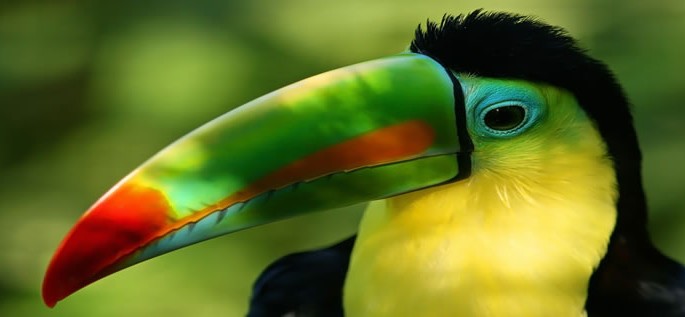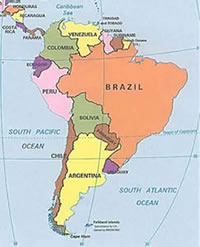
Indigenous Languages of South America
South America is one of the most linguistically diverse areas in the world with 37 language families, 448 languages of which over 70 are unclassified. Indigenous languages are used throughout the entire continent. They are spoken by over 11 million people alongside Spanish and Portuguese. Although it is generally established that South American Indians migrated from the north, none of their languages are related to the language families of North and Central America. Below is a comparison of the language situation in the three Americas based on data from Ethnologue.
|
Number of language families
|
Number of languages
|
Average number of languages per family
|
|
|---|---|---|---|
| North America |
13
|
220
|
16.9
|
| Central America |
6
|
273
|
45.5
|
| South America |
37
|
448
|
12.1
|

Some linguists believe that the indigenous languages of South America may all have evolved from a common ancestor. The great linguistic variety of South America may have resulted from the lack of contact over a very long period of time. In the absence of historical records and writing, it is difficult to reconstruct the intermediate stages that might have allowed the reconstruction of a common ancestor of these languages. In addition, incomplete knowledge about many indigenous languages makes it difficult to determine the difference between a dialect and a language on the one hand, a family (composed of languages), and a stock (composed of families or very different languages) on the other. At the moment, these can be determined only tentatively.
Despite considerable work done by linguists, ethnographers and missionaries, especially in the 20th century, few indigenous languages of the South American continent have been adequately analyzed and described. There are many tribes consisting of small numbers of people living in remote jungle areas where linguistic field work is extremely difficult. Even in the more accessible areas, there is considerable uncertainty over the identity of the languages and the boundaries between them.
There is also great confusion regarding the names of languages and language families, due to the different orthographic traditions of Spanish and Portuguese, and to the lack of a standardized classification scheme. A language variety may be considered a dialect by one author, and a separate language by another. The same goes for language families.
South America has more language families and more languages but has fewer languages per family than North and Central America. Only a few South American language families have more than 10 languages. They are listed below.
|
Language family
|
Number of languages
|
Spoken in
|
|---|---|---|
| Arawakan |
64
|
Arawakan languages formerly extended from the peninsula of Florida in North America to the present-day Paraguay–Argentina border, and from the foothills of the Andes eastward to the Atlantic Ocean. Arawakan languages are still spoken in Brazil, Peru, Colombia, Venezuela, Guyana, French Guiana, and Suriname. |
| Carib |
32
|
Carib languages were spoken mostly north of the Amazon extending as far as the Mato Grosso in Brazil. They have declined drastically. Today they are spoken by some 20,000 people mostly in Venezuela and Colombia. |
| Chibchan |
22
|
Chibchan languages, which form the linguistic bridge between South and Central America, are spoken from Nicaragua to Ecuador. They are spread compactly in Central America and in western Colombia and Ecuador. |
| Choco |
12
|
The languages in this family all have small populations of speakers mostly in Colombia and Panama. |
| Macro-Ge |
32
|
Macro-Ge is geographically the most compactly distributed of the big South American language families. Macro-Ge languages are spoken throughout inland eastern Brazil and Bolivia. |
| Mataco–Guaicuru |
12
|
The languages in this family all have small populations of speakers mostly in Argentina, Brazil, and Paraguay. |
| Panoan |
28
|
The languages in this family all have small populations of speakers mostly in Brazil, Peru, and Bolivia. |
| Quechuan |
46
|
This is a large family consisting of various Quechua varieties, many of them not mutually intelligible. There is considerable disagreement whether these are separate languages or dialects of the same language. They are spoken mostly in Peru, Eduador, Bolivia, Chile, and Argentina. |
| Tucanoan |
25
|
The languages in this family all have small populations of speakers mostly in Colombia, Brazil, Ecuador. |
| Tupi-Guarani |
76
|
Tupi languages were spoken south of the Amazon, from the Andes to the Atlantic Ocean and down to the Rio de la Plata. Today, they are spoken by 2.2 million people in Paraguay, Bolivia, and Brazil. |
Most of the indigenous languages of South American have small populations of speakers. The most populous languages are listed below:
|
Language
|
Language Family
|
Number of speakers
|
Spoken in
|
|---|---|---|---|
| Quechua | Quechuan | 8.5 million | Peru, Brazil, Bolivia, Argentina, Ecuador, Colombia |
| Guarani | Tupi-Guarani | 4.8 million | Paraguay |
| Aymara | Aymaran | 2.2 million | Bolivia |
| Wayuu | Arawakan | 305,000 | Colombia, Venezuela |
| Kuna | Chibchan | 58,500 | Panama, Colombia |
| Embera | Choco | 50,000 | Panama, Colombia |
| Shuar | Jivaroan | 46,700 | Ecuador |
| Asháninka | Arawakan | 23,000 to 28,500 | Peru |
| Ticuna | Unclassified | 25,000 | Brazil |
Status
Only Quechua in Bolivia and Guaraní in Paraguay have official status along with Spanish. The rest of the languages have no recognized status. Many are severely endangered or on the brink of extinction because people who speak them are under tremendous social, economic, and political pressures to switch to Spanish or Portuguese (in Brazil). Majority of indigenous people in Latin America are bilingual, speaking both their native language and the national language. Many are multilingual, speaking several indigenous languages in addition to Spanish or Portuguese. Even languages with relatively large populations of speakers are in danger of disappearing by the end of the 21st century unless their governments initiate and maintain effective language preservation programs.
Dialects
Structure
Sound systems
The sound systems of indigenous South American languages are extremely diverse and share few phonological features, except for the absence of complex consonant clusters. The number of phonemes, i.e., sounds that distinguish word meaning, ranges from 42 in Jaqaru to 17 in Asháninka. Quechua has only three vowels, while Apinayé has ten oral and 7 nasal vowels. Some languages have tonal stress with a range of two to five different tones. Many distinguish between oral and nasal vowels.
Grammar
Grammatical systems of the indigenous languages of South America are extremely diverse. Most of them are agglutinative, i.e., they add prefixes and/or suffixes to roots to form words and to express grammatical functions.
Nouns
Case are usually marked by suffixes or postpositions. Prepositions are rarely used.
Pronouns
Many languages distinguish between inclusive and exclusive first person plural (we including and we excluding the hearer).
Verbs
In many languages, verb forms incorporate the subject, object, and negation. Tense and aspect marking varies from language to language.
Word order
Varies from language to language.
Vocabulary
The indigenous languages of South America have widely divergent vocabularies. Similarities can be found in the numerous loanwords in in areas where the indigenous people of South America had come in close contact with Spanish or Portuguese. Below are the numerals 1-10 in three languages.
|
1
|
2
|
3
|
4
|
5
|
6
|
7
|
8
|
9
|
10
|
|
|---|---|---|---|---|---|---|---|---|---|---|
| Quechua |
hoq
|
iskay
|
kinsa
|
tawa
|
pisqa
|
soqta
|
qanchis
|
pusaq
|
isqon
|
chunka
|
| Aymara |
maya
|
paya
|
kimsa
|
pusi
|
phisqa
|
suxta
|
paqallqu
|
kimsaqallqu
|
llantunka
|
tunka
|
| Guaraní |
peteĩ
|
mokõi
|
mbohapy
|
irundy
|
po
|
poteĩ
|
pokõi
|
poapy
|
porundy
|
pa
|
Writing
South American indigenous languages are written with the Latin script. Spanish and Portuguese missionaries developed their orthographies basing them on the orthographic traditions of Spanish and Portuguese. As a result, many of the orthographies do not accurately reflect the distinctive sound features of the indigenous languages of South America. Orthographies have existed since the 17th century for some languages such as Guaraní and Quechua, but for most other languages, orthographies have been devised quite recently. And there are still a number of languages that lack writing systems.
Literacy rates in the indigenous languages are extremely low, so efforts are being made to promote literacy in these languages.
Difficulty
 How difficult is it to learn Indigenous Languages of South America?
How difficult is it to learn Indigenous Languages of South America?There is no data on the difficulty of South American Indian languages for speakers of English.